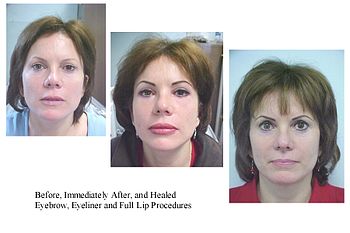Permanent makeup
Complications include allergic reactions, migration of pigment, or even infections, which underscore the importance of high-quality materials and skilled technicians.
As permanent makeup gradually gained popularity, its safety concerns, regulatory challenges, and options for removal also attracted attention.
"[3] The tattooist George Burchett, a major developer of the technique in the 1930s, described in his memoirs how beauty salons tattooed many women without their knowledge, offering it as a "complexion treatment... of injecting vegetable dyes under the top layer of the skin.
[8] This is especially useful for older women whose eyesight might not be good enough to apply the makeup[9] or who have degenerative diseases such as Parkinson's which severely limits motor ability.
[9] In a study done regarding the possible complications of permanent makeup, the most common side effects were itching, redness, and the occasional swelling, all of which tended to heal after a few days.
[15] While uncommon, permanent makeup can potentially come with more serious complications, including allergic reactions to the pigments, infection, granulomas, keloids, bleeding, crusting, loss of eyelashes, or general damage to the tattooed area.
[11][16] Although properly trained technicians will maintain sterile conditions during application,[17] the use of unsterilized tattooing instruments may also infect the patient with serious diseases such as HIV and hepatitis.
On very rare occasions, people with permanent makeup have reported swelling or burning in the affected areas when they underwent magnetic resonance imaging (MRI).
[19][20] Permanent makeup can also reportedly affect the quality of an MRI image, however, complications can be avoided as long as medical professionals are previously informed.
